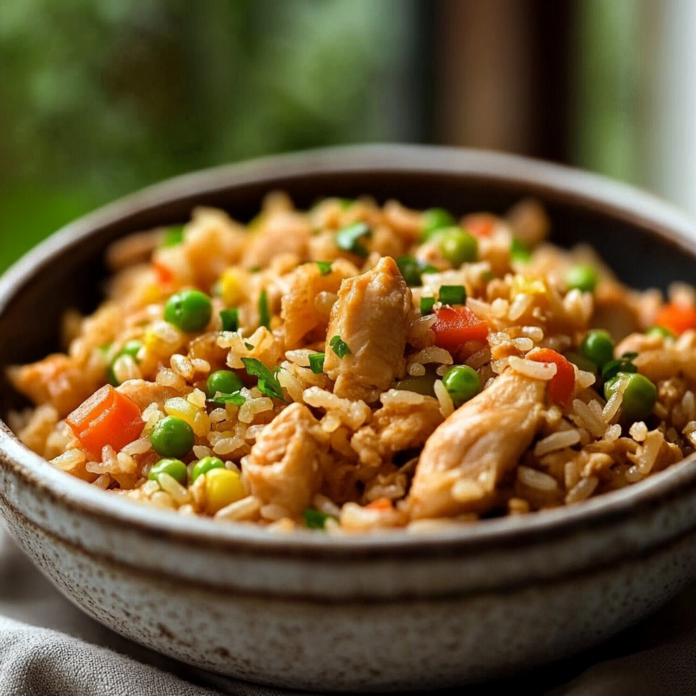Introduction and Quick Summary
Chicken Fried Rice is a beloved dish that brings together tender pieces of chicken, colorful vegetables, and perfectly cooked rice. This comforting meal is not just delicious but also incredibly versatile. You can enjoy it as a main course or as a side dish. Whether you’re cooking for yourself or feeding a crowd, this dish is sure to please everyone at the table.
What makes Chicken Fried Rice so appealing is its balance of flavors and textures. The savory taste from the soy sauce blends beautifully with the sweetness from the vegetables. Plus, it’s an excellent way to use up leftover ingredients from your fridge. By incorporating fresh vegetables and proteins you already have on hand, you can create a satisfying meal without wasting food.
In this article, we will guide you through the main ingredients needed for this delightful dish and provide detailed step-by-step instructions for preparing Chicken Fried Rice at home. We’ll also cover serving suggestions and storage tips to help you get the most out of your amazing creation. So let’s dive in and discover how to make this delicious Chicken Fried Rice that will impress family and friends alike!
Main Ingredients
Cooked Rice
Rice is the star ingredient in any fried rice dish. For best results, use long-grain white rice or jasmine rice as these varieties hold their shape well when stir-fried. It’s ideal to use day-old rice because it’s drier and prevents clumping. If you are preparing fresh rice, allow it to cool completely before using it in your recipe. For four servings of Chicken Fried Rice, you’ll need about 4 cups of cooked rice.
Chicken Breast
For protein-packed goodness, diced boneless skinless chicken breasts work wonders in this dish. About 1 pound should suffice for four servings. Choose high-quality chicken to ensure tenderness and flavor in your fried rice. Cut the chicken into small bite-sized pieces for even cooking. Seasoning the chicken with salt and pepper enhances its flavor before cooking.
Mixed Vegetables
A colorful mix of vegetables adds texture and nutrients to your Chicken Fried Rice. Common choices include peas, carrots, bell peppers, and corn; about 1 cup total is recommended. Fresh or frozen veggies both work well—just be sure to thaw frozen ones beforehand if using them. Chopping vegetables into uniform pieces ensures they cook evenly alongside the other ingredients.
Soy Sauce
Soy sauce is essential for imparting that signature umami flavor that makes fried rice so deliciously addictive. Use about 3 tablespoons of low-sodium soy sauce to avoid overpowering saltiness while still providing rich flavor. If you prefer a gluten-free option or want to experiment with flavors, consider tamari or coconut aminos as alternatives.
Green Onions
Green onions add freshness and a mild onion flavor to your dish. You’ll need about 3-4 stalks chopped finely—both white and green parts can be used. They are typically added towards the end of cooking to retain their crispness while complementing the overall flavors nicely.
Eggs
Eggs serve as both a binder and an additional source of protein in Chicken Fried Rice. Using about 2 large eggs will give your dish a creamy texture when scrambled into the mix during cooking. Ensure they’re well-beaten beforehand for even distribution throughout the fried rice.
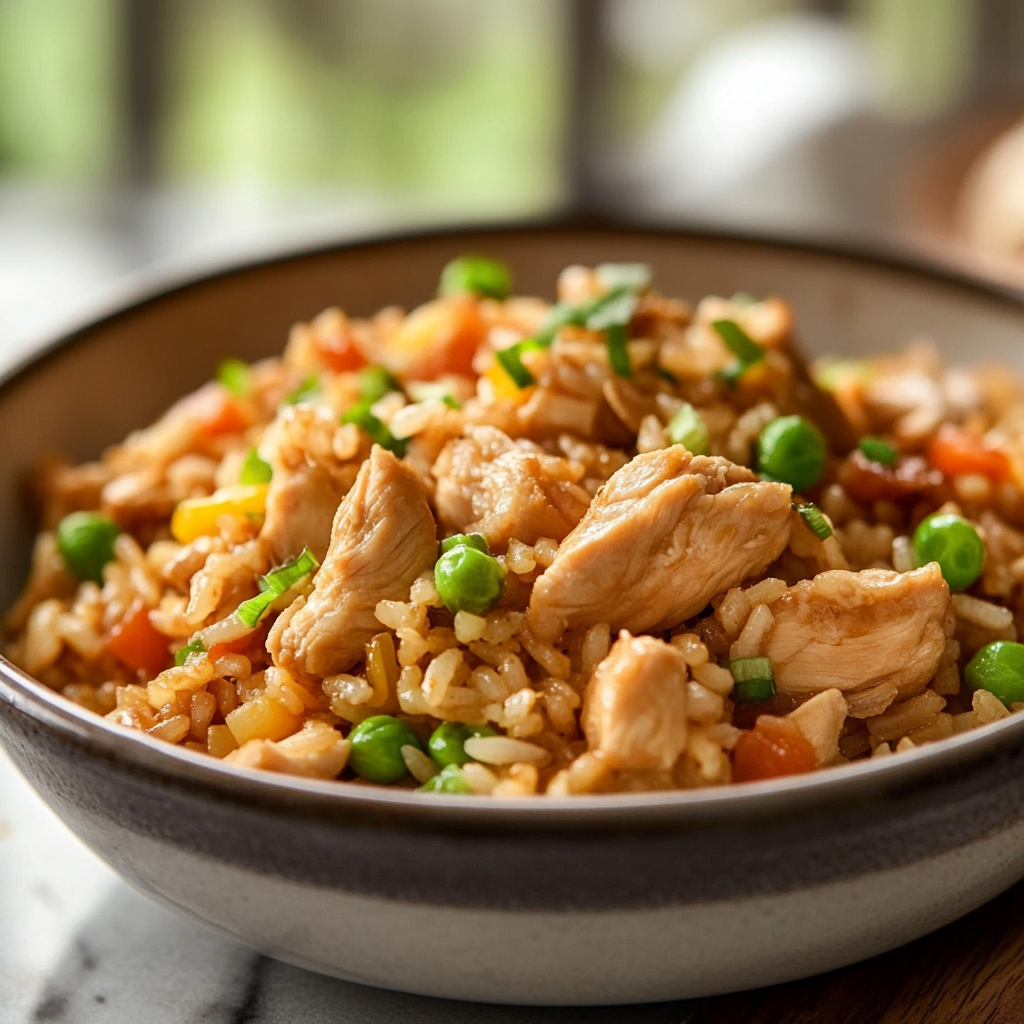
How to Prepare Chicken Fried Rice
Step 1: Gather Your Ingredients
Before starting the cooking process for your Chicken Fried Rice, gather all necessary ingredients including cooked rice, diced chicken breast, mixed vegetables, soy sauce, chopped green onions, and beaten eggs. Having everything ready allows for smooth transitions between steps without losing momentum while cooking.
Step 2: Cook the Chicken
In a large skillet or wok over medium-high heat, add about 2 tablespoons of oil suitable for frying (like vegetable or sesame oil). Once hot enough (you can test by adding a small piece of chicken), add your diced chicken breast seasoned with salt and pepper directly into the pan. Allow it to cook undisturbed for about 5-7 minutes until browned on one side before stirring occasionally until fully cooked through (internal temperature should reach 165°F). Transfer cooked chicken onto a plate while keeping it warm.
Step 3: Scramble the Eggs
Using the same skillet where you cooked your chicken helps retain flavors in your dish! Add another tablespoon of oil if necessary—then pour in your beaten eggs immediately after removing excess moisture from previous cooking activities like grease splatter! Stir continuously until fully scrambled (around 2-3 minutes), then push them aside within the pan creating space for remaining ingredients later on.
Step 4: Stir-Fry Vegetables
With scrambled eggs set aside temporarily within their own section in pan/wok space; it’s time now to introduce those vibrant mixed veggies! Add them all at once into heated pan ensuring even coverage across surface area before stirring occasionally allowing them warmth (around 4-5 minutes). Aim just enough tenderness without excessive mushiness preserving crunch factor which elevates final texture profile immensely!
Step 5: Combine Everything Together
Once veggies appear tender yet still vibrant; return previously prepared components (chicken & eggs) back into mixture thoroughly combining all elements together while pouring soy sauce over top achieving desired flavor infusion evenly distributed across entire volume being mindful not over-saturate leading soggy outcome instead maintaining balance throughout! Continue tossing/stirring everything together so nothing sticks/burns bottom layer until heated through again roughly another few minutes—then finish off sprinkling with chopped green onions right before serving hot!
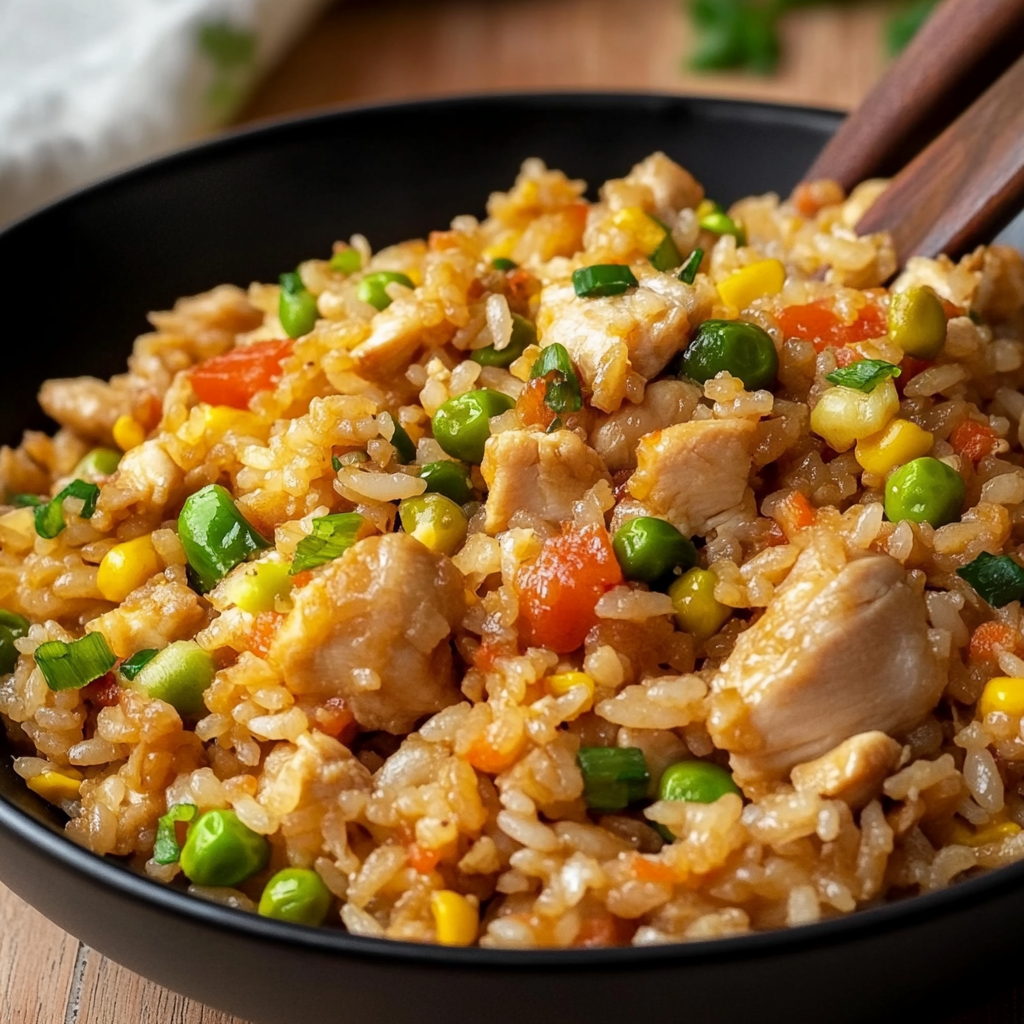
Serving and Storing Tips
Serving Suggestions
When serving your freshly made Chicken Fried Rice there are countless topping options available enhancing overall experience further! Consider offering additional sauces like sweet chili sauce or extra soy sauce on side allowing customization based personal preferences amongst guests gathered around table sharing meal together fostering camaraderie building lasting memories over delicious food enjoyed shared conversations! You could also pair it with crispy spring rolls or egg rolls which complement flavors nicely making complete feast everyone will rave about long after dining event concludes leaving smiles all around!
Storage Guidelines
If you happen to have leftovers after enjoying this delectable dish do not fret! Properly storing leftover Chicken Fried Rice ensures freshness retained while minimizing waste—transfer cooled portions directly into airtight containers before placing inside refrigerator where they’ll remain good quality stored safely up-to three days max providing ample opportunity reheating later-on easily utilizing microwave method which yields great results restoring original taste profile! Alternatively consider freezing single-serving sizes wrapped tightly foil/plastic wrap followed by placing sealed bags within freezer lasting upto three months providing convenient meals ready whenever cravings strike unexpectedly!
By following these guidelines closely anyone can craft their own version restaurant-style homemade Chicken Fried Rice bringing joy directly onto plates instantly transforming ordinary weeknight dinners into delightful occasions bursting flavorful satisfaction leaving everyone asking seconds guaranteed every time served hot!
Mistakes to avoid
When preparing Chicken Fried Rice, several common mistakes can hinder your dish’s quality. First, using the wrong type of rice can lead to a mushy texture. Ideally, you should use day-old rice, as it has dried out slightly and will fry better. Freshly cooked rice often results in clumps, making it difficult to achieve that desired fried texture.
Another mistake is overcrowding the pan. If you add too many ingredients at once, the heat will drop significantly, causing steaming rather than frying. Cook in smaller batches; this ensures that your Chicken Fried Rice gets that perfect sear and flavor.
Not seasoning correctly can also ruin your dish. Many people forget to season between steps; remember to add salt and pepper while cooking your chicken and vegetables. This layering of flavors elevates the overall taste of your Chicken Fried Rice.
Additionally, neglecting to prep your ingredients beforehand can be detrimental. When working with high heat, timing is crucial. Make sure all ingredients are chopped and ready to go before starting to cook; this avoids delays and keeps everything moving smoothly.
Lastly, overcooking the vegetables can lead to a loss of texture and nutrients. Aim for tender but crisp vegetables; they should retain some crunch to complement the chicken and rice effectively.
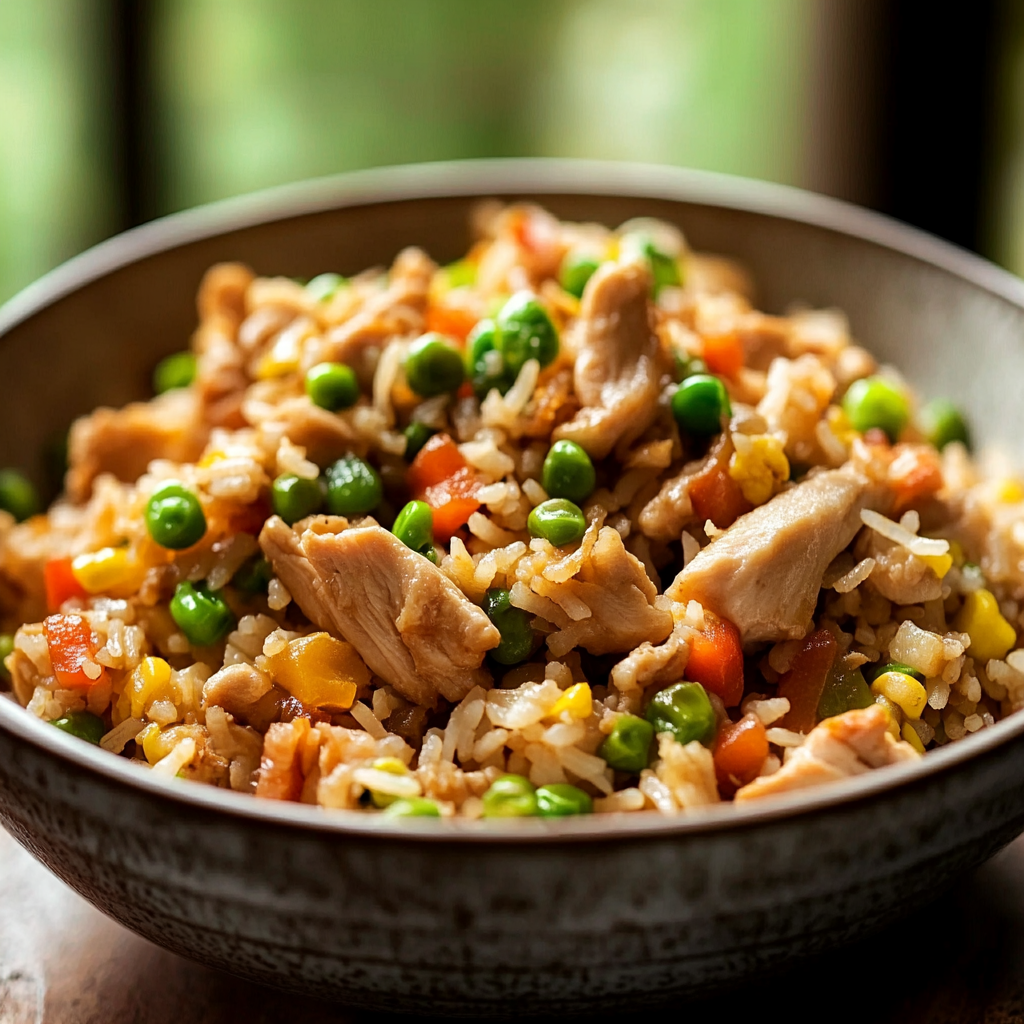
Tips and tricks
To master Chicken Fried Rice, consider these helpful tips. Firstly, utilize high-quality soy sauce for authentic flavor depth. A combination of light and dark soy sauce can enhance the umami profile of your dish, giving it a restaurant-quality taste.
Experimenting with different proteins is another way to elevate your dish. While chicken is traditional, feel free to substitute shrimp or tofu for variety. This flexibility allows you to cater the recipe based on dietary restrictions or personal preferences.
Using a wok instead of a regular skillet can vastly improve your cooking experience. Woks distribute heat evenly and allow for better tossing of ingredients without spilling them out of the pan. This technique is vital for achieving that signature fried rice look and feel.
Don’t forget about aromatics such as garlic and ginger; adding these early in the cooking process builds layers of flavor that enhance the final result. Sauté them until fragrant before introducing other ingredients for maximum impact.
Lastly, finish off your Chicken Fried Rice with a drizzle of sesame oil or a sprinkle of green onions just before serving. These finishing touches provide an extra layer of flavor that makes a significant difference in taste.
Suggestions for Chicken Fried Rice
For an exceptional Chicken Fried Rice experience, consider using fresh vegetables like bell peppers and snap peas for added color and crunch. These veggies not only enhance visual appeal but also introduce varying textures that make every bite exciting.
Incorporate eggs into your fried rice by scrambling them separately first before mixing them in with the chicken and vegetables. This technique ensures even distribution throughout the dish while adding richness and protein content.
If you’re looking for a bit more spice, think about adding chili paste or sriracha during cooking. Adjust according to personal preferences; these additions can range from mild enhancements to bold flavors that really kick things up a notch.
Consider marinating your chicken briefly before cooking it in soy sauce, garlic, and ginger mixture. This extra step infuses more flavor into the meat while keeping it tender when cooked quickly over high heat—a key factor in creating perfect Chicken Fried Rice.
Lastly, don’t shy away from garnishing with fresh herbs like cilantro or basil after plating. These herbs not only provide freshness but also elevate the overall presentation of your dish—making it as appealing visually as it is delicious!
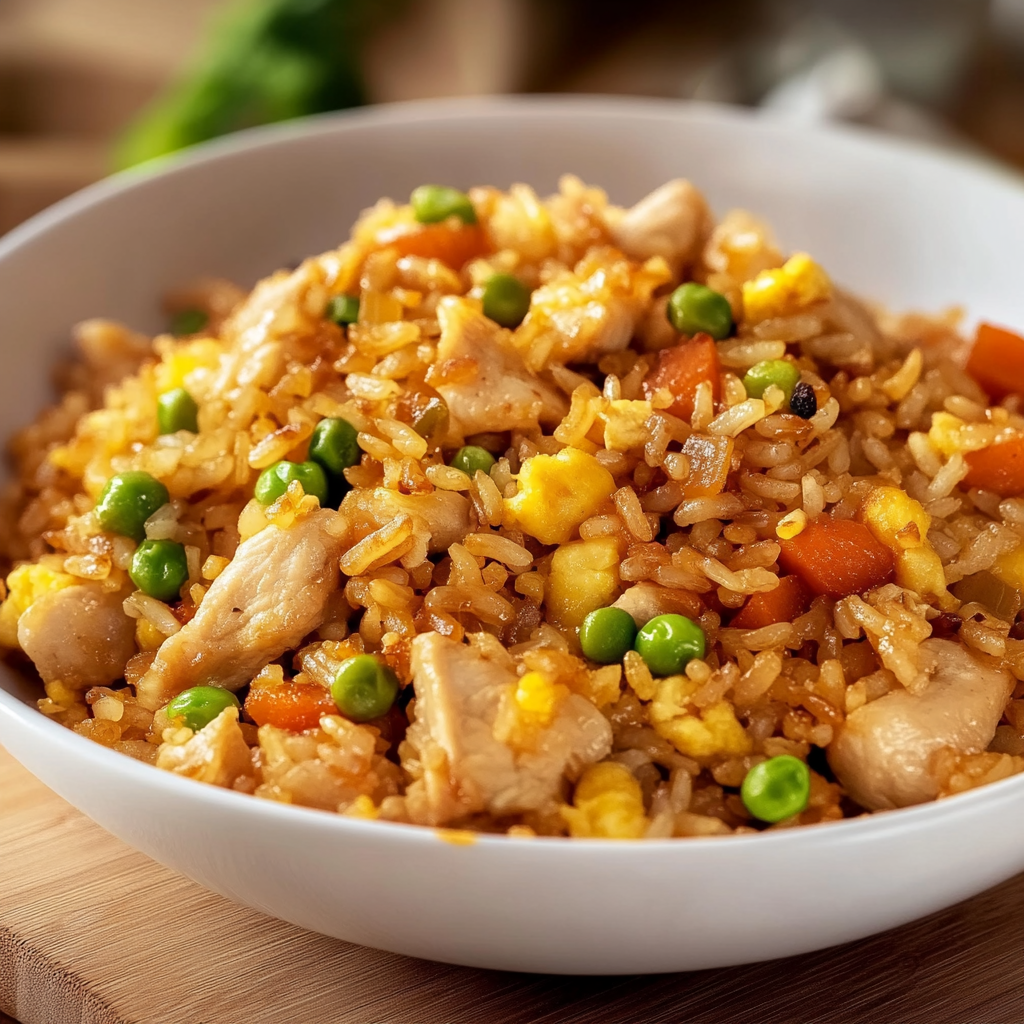
FAQs
What type of rice is best for Chicken Fried Rice?
The best type of rice for Chicken Fried Rice is day-old white rice or jasmine rice due to its lower moisture content compared to freshly cooked rice. Day-old rice has had time to dry out in the refrigerator, which helps achieve that ideal fluffy texture when stir-fried. If you don’t have leftover rice on hand, try making your rice earlier in the day—allowing it time to cool completely before using it in this recipe will help maintain its integrity during frying.
Can I use frozen vegetables in Chicken Fried Rice?
Yes! Using frozen vegetables can be a convenient option when making Chicken Fried Rice. They are often flash-frozen at peak freshness so they retain their nutrients well. Just be sure to thaw them beforehand or add them directly from frozen while allowing additional cook time for any excess moisture to evaporate—this prevents sogginess in your final dish.
How do I store leftover Chicken Fried Rice?
To store leftover Chicken Fried Rice properly, let it cool down first before transferring it into an airtight container. You can keep it refrigerated for up to four days or freeze portions if you want longer storage life—just make sure it’s fully cooled before freezing! To reheat leftovers effectively without compromising texture, use a skillet over low heat with a splash of water or broth; this will help steam any dry bits back into shape!
Can I make Chicken Fried Rice vegetarian?
Absolutely! To create a vegetarian version of Chicken Fried Rice simply replace chicken with tofu or tempeh as protein substitutes while ensuring you maintain flavorful elements like soy sauce in your marinade mix! Also consider including more assorted vegetables like mushrooms or zucchini—these additions will make your vegetarian fried rice vibrant while still satisfying!
What spices work well with Chicken Fried Rice?
Common spices that complement Chicken Fried Rice include ground black pepper, garlic powder, onion powder along with optional red pepper flakes if you’re looking for some heat! Additionally adding five-spice powder provides an aromatic touch commonly found in Asian cuisine which further enhances flavors within this beloved dish!
How do I prevent my fried rice from becoming mushy?
To prevent mushy fried rice ensure you start with properly cooled day-old grains! If using freshly made variety be sure not overcrowd frying pan while cooking since steam trapped inside leads towards soggy results instead strive for quick high-heat contact throughout process allowing each grain stand alone yet thoroughly coated by seasonings – achieving perfection every single time!
Conclusion
In summary, mastering the art of making Chicken Fried Rice involves avoiding common pitfalls such as using fresh rice instead of day-old varieties or overcrowding your cooking surface. Utilizing effective tips like opting for high-quality soy sauce and incorporating various proteins enriches both flavor profiles and nutritional content.
Moreover, suggestions such as adding fresh herbs or scrambling eggs separately contribute significantly towards enhancing both presentation aesthetic alongside taste complexity too! Lastly addressing frequently asked questions about optimal storage methods or how one could effortlessly transition this classic dish into vegetarian-friendly options assures wide adaptability suitable across diverse culinary preferences!
By following these guidelines diligently you’ll find yourself creating delicious meals worthy enough impress family friends alike – all while indulging within savory comfort food everyone loves so much!
